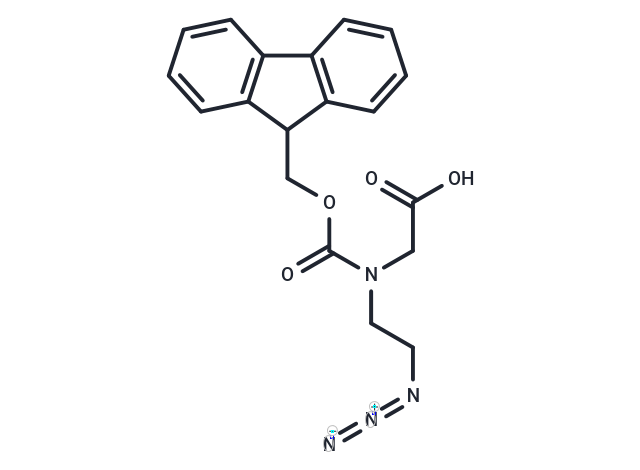- Remove All
 Your shopping cart is currently empty
Your shopping cart is currently empty
Fmoc-Aeg(N3)-OH
Fmoc-Aeg(N3)-OH is a click chemistry reagent characterized by its azide group that participates in copper-catalyzed azide-alkyne cycloaddition reactions (CuAAc) with molecules containing alkyne groups. This building block, which also reacts in strain-promoted alkyne-azide cycloaddition (SPAAC) with DBCO or BCN group-containing molecules, facilitates the alteration of cytotoxicity through the creation of peptidomimetics such as Cilengitide, Piscidin 1, and MC3, MC4, MC5 receptor agonists. Its incorporation in molecules can lead to conformational restraint in peptidic structures due to amidic nitrogen alkylation, which results in structures such as N-methylated peptides, allows backbone derivatization, and enables the design of macrocycles through intramolecular cross-linking or stabilization of the main chain by intramolecular cyclization. Fmoc-Aeg(N3)-OH is a potential cornerstone for the construction of custom peptide nucleic acids (PNAs) and peptide synthesis.

Fmoc-Aeg(N3)-OH
| Pack Size | Price | Availability | Quantity |
|---|---|---|---|
| 10 mg | Inquiry | 10-14 weeks | |
| 50 mg | Inquiry | 10-14 weeks |
Product Introduction
| Description | Fmoc-Aeg(N3)-OH is a click chemistry reagent characterized by its azide group that participates in copper-catalyzed azide-alkyne cycloaddition reactions (CuAAc) with molecules containing alkyne groups. This building block, which also reacts in strain-promoted alkyne-azide cycloaddition (SPAAC) with DBCO or BCN group-containing molecules, facilitates the alteration of cytotoxicity through the creation of peptidomimetics such as Cilengitide, Piscidin 1, and MC3, MC4, MC5 receptor agonists. Its incorporation in molecules can lead to conformational restraint in peptidic structures due to amidic nitrogen alkylation, which results in structures such as N-methylated peptides, allows backbone derivatization, and enables the design of macrocycles through intramolecular cross-linking or stabilization of the main chain by intramolecular cyclization. Fmoc-Aeg(N3)-OH is a potential cornerstone for the construction of custom peptide nucleic acids (PNAs) and peptide synthesis. |
| Molecular Weight | 366.37 |
| Formula | C19H18N4O4 |
| Cas No. | 1935981-35-3 |
| Storage | Powder: -20°C for 3 years | In solvent: -80°C for 1 year | Shipping with blue ice. |
Sci Citations
Calculator
In Vivo Formulation Calculator (Clear solution)
Dose Conversion
Tech Support
Keywords

Copyright © 2015-2025 TargetMol Chemicals Inc. All Rights Reserved.




